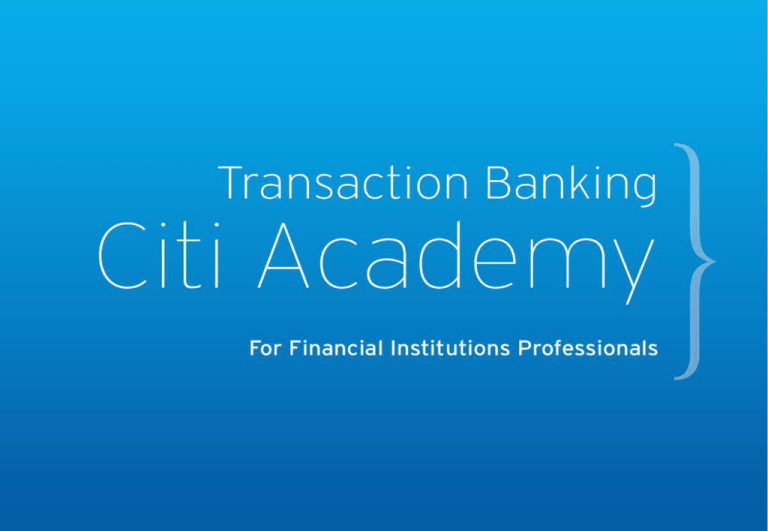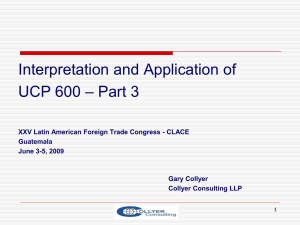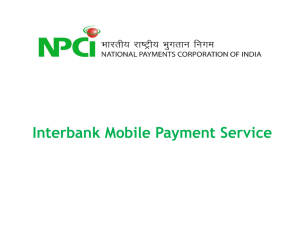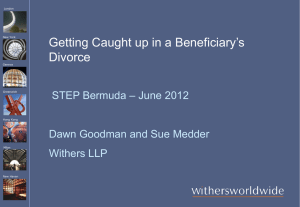
Understanding the Main Rules of UCP600
Pamela Woon, Regional Trade Advisor
Citi Transaction Banking Academy for Financial Institutions Professionals | August 2014
AGENDA
1. REFRESHER ON THE FOLLOWING RULES OF UCP 600
- UCP 600 Article 1, 2, 3, 6,7,8,9,10,12,14,16,32,35 and 38
2. CASE STUDIES
5
Understanding the Main Rules
UCP 600 Article 1 - Application of UCP
rules that apply provided there is express indication
extends to standby letters of credit
allows for modification and exclusions
elimination of the phrase “unless otherwise stipulated in the credit”
throughout UCP 600;
There is a need to understand the concept of modification and exclusion and when
it is appropriate and when it is not.
6
Understanding the Main Rules
UCP 600 Article 2 – Meaning of Negotiation
Negotiation means the purchase by the nominated bank
- of drafts (drawn on a bank OTHER than the nominated bank)
- and/or documents under a complying presentation,
- by advancing
- or agreeing to advance funds to the beneficiary
- on or before the banking day on which reimbursement is due
FAQS:
1) What is advancing funds?
2) What is agreeing to advance?
3) With or without recourse?
4) Is the agreement to advance funds conditional?
7
Understanding the Main Rules
UCP 600 Article 3 - Interpretations
A document may be SIGNED by:
- handwriting,
- facsimile signature,
- perforated signature,
- stamp,
- symbol or
- any other mechanical or
- electronic method of authentication
FAQS:
1) What is a facsimile signature?
2) What is electronic / mechanical method of authentication?
8
Understanding the Main Rules
UCP 600 Article 6 - Availability, Expiry Date and Place for Presentation
A credit must state the bank with which it is available or whether it is available with
any bank. A credit available with a nominated bank is also available with the issuing
bank.
A credit must state an expiry date for presentation. An expiry date stated for
honor or negotiation will be deemed to be an expiry date for presentation
The place of the bank with which the credit is available is the place for presentation. The place
for presentation under a credit with any bank is that of any bank.
A place for presentation other than that of the issuing bank is in addition to the
place of the issuing bank.
9
FAQ’s
∞ LC is available with ABC Bank as the nominated bank (NB)
∞
Beneficiary presented documents to their own bank , DEF Bank
∞ Beneficiary does not require nominated bank to act on nomination
To whom should beneficiary requests DEF Bank to present their documents– to the
nominated bank or the issuing bank directly?
DEF Bank should be instructed to present documents to the NB especially if the latest
presentation date or expiry date is imminent. Else, documents must reach the IB on
OR before the latest presentation date (LPD) or expiry.
In sending the documents to the issuing bank, beneficiary takes the risk of nondelivery
In the event of IB finding discrepancies in the documents , beneficiary may find it
impossible to correct them within any remaining presentation period or expiry date.
FAQ’s
∞ A Credit was issued by Bank A in Country A making availability with Bank B in
Country B and expiry at issuing bank's counters
∞ Documents presented to Bank B within the presentation period and expiry
Can Bank B honour or negotiate ?
Can Bank A refuse the documents if not received within the LC stipulated timeframe?
This is not the ideal situation. This means that if Bank B decide to honour or
negotiate, this act must occur within the expiry date and presentation period, and
they must ensure that the documents reach the issuing bank within those dates.
Bank B may be unwilling to act on nomination unless the expiry place is
amended to their counter in Country B.
Bank A is entitled to reject the documents if not received by them at their
counters on or before expiry date and/or any latest presentation date.
FAQ’s
∞ Bank A issued an LC available with Bank B by acceptance
∞ Bank B is unwilling to accept the draft since it is not the confirming bank.
Should the beneficiary draw the draft on the issuing bank and confirming bank if any ?
If no draft is presented, is this a discrepancy?
Absence of a draft, can issuing / confirming bank use this as a basis for refusal?
Where a draft is presented, the issuing or confirming bank would be required to
accept it. If no draft is presented, a deferred payment undertaking would be given.
FAQ’s
∞ LC states place of expiry as China & available with ANY bank
∞ Beneficiary's address is in HK
Are there any restrictions as to the location of the bank that is allowed to present
documents and act as negotiating bank?
Can a bank located in Macau / HK claim that they acted on the nomination and certify
that the documents were presented within LC validity?
The ICC position remains that China, HK and Macau would be different
countries for the purpose of the LC.
This position was given post the handover of HK to China.
Given this position, it may be unwise to act on the nomination unless the bank
is based in mainland China.
Understanding the Main Rules
UCP 600 Article 7 - Issuing Bank Undertaking
An issuing bank must honor a complying presentation
An issuing bank is irrevocably bound to honour as of the time it issues the credit.
An issuing bank undertakes to reimburse a nominated bank that has honoured or
negotiated a complying presentation and forwarded the documents to the issuing
bank.
Reimbursement for the amount of a complying presentation under a credit
available by acceptance or deferred payment is due at maturity, whether or not
the nominated bank prepaid or purchased before maturity.
An issuing bank's undertaking to reimburse a nominated bank is independent of
the issuing bank's undertaking to the beneficiary.
FAQS:
1) May an issuing bank refuse to pay if a court injunction was issued?
14
FAQ’s
∞ On June 1, Bank I issues a credit through Bank A favoring Beneficiary B
∞ Bank A was not able to contact Beneficiary B to advise the Credit.
∞ On June 5, Bank A receives a cancellation request from Bank I and to advise the
credit to Beneficiary C
Since Beneficiary B is unaware of the existence of a credit because he could not be
contacted by the correspondent bank, and so does not have the operative instrument,
is it CORRECT that his consent to cancellation need not be obtained in order to advise
the LC to another beneficiary?
Sub-article 7 (b) states "An issuing bank is irrevocably bound to honour as of the
time is issues the credit."
On the basis of this rule, the issuing bank is liable to honour as of the moment
the LC is issued and irrespective of when/if the beneficiary can be contacted.
As a result, the credit can only be cancelled with the consent of the beneficiary.
Understanding the Main Rules
UCP 600 Article 8- Confirming Bank Undertaking
16
Provided that the stipulated documents are presented to the confirming bank or to any other
nominated bank and that they constitute a complying presentation, the confirming bank must
honour or negotiate without recourse.
A confirming bank is irrevocably bound to honour or negotiate as of the time it
adds its confirmation to the credit.
A confirming bank undertakes to reimburse a nominated bank that has honoured
or negotiated a complying presentation and forwarded the documents to the
confirming bank.
Understanding the Main Rules
UCP 600 Article 8- Confirming Bank Undertaking
17
Reimbursement for the amount of a complying presentation under a credit
available by acceptance or deferred payment is due at maturity, whether or not
the nominated bank prepaid or purchased before maturity.
A confirming bank's undertaking to reimburse a nominated bank is independent
of the confirming bank's undertaking to the beneficiary.
A confirming bank must inform the issuing bank without delay if it is not
prepared to do so and may advise without confirmation
FAQ’s
∞ Bank I issues a credit indicating in field 49 "CONFIRM"
∞ Bank A advised the credit to Beneficiary and added its confirmation without seeking
their consent
Is Bank A within their right to confirm the credit as instructed by the issuing bank,
without consent of the beneficiary, providing the beneficiary does not object to
adding of confirmation?
What is the difference when field 49 indicates “MAY ADD” ?
Where the credit states "confirm" there is no requirement for a bank, that
is requested to confirm, to seek the agreement of the beneficiary before
doing so.
Where the credit states "may add", it is usual for the bank to advise the
credit on an unconfirmed basis stating that they are authorised to add
their confirmation upon receipt of a request from the beneficiary
together with payment of the confirmation fee (if charges are for account
of the beneficiary).
FAQ’s
∞ Bank I issues a Credit which is available "by payment at sight" with drafts drawn on
the confirming bank, Bank C
∞ On June 1, documents presented were deemed clean by Bank C
∞ On June 1, Bank C lodged a claim on Reimbursing Bank , Bank R value June 4
When should the confirming bank Bank C effect payment to the beneficiary?
A. June 1
B. June 4
C. Only when funds are received from the reimbursing bank
The beneficiary should be paid with the same value date that is requested
from the reimbursing bank. Ie. June 4
In the event that funds are not received on June 4, the confirming bank is
entitled to claim interest from the issuing bank.
A confirmation does not allow a confirming bank to pay on receipt of funds.
A confirmation is intended to cover the payment risk under that credit.
FAQ’s
∞ UCP600 Article 8: Provided a complying presentation is presented to the Confirming
Bank or to any other nominated bank, the confirming bank MUST honor/ negotiate
if the Credit is available by sight payment / deferred payment/ acceptance or
negotiation.
Is there a difference in the obligation of a confirming bank depending on the manner
of availability?
How do the obligations of a confirming bank in an L/C available by negotiation, with
drafts drawn on the issuing bank, differ from that of a credit available by payment or
acceptance, with drafts drawn on the confirming bank?
Under each type of availability Confirming Bank must honor or negotiate a
complying presentation on a without recourse basis.
Some banks that are requested to confirm a credit will do so only on the
basis that it is available with them by payment or acceptance (or deferred
payment) as opposed to negotiation.
This is entirely down to the internal policy of the concerned confirming bank
FAQ’s
∞ Bank I had originally advised the maturity date under a Deferred Payment Credit as
July 31 where Bank C had added their confirmation.
∞ Prior to maturity, Bank C received an amendment from Bank I extending the
maturity date to September 30 to which the beneficiary is willing to give consent.
If Bank C is not willing to extend , does their undertaking to the beneficiary still holds?
Bank C has the following options, either :
Agree to the amendment ( and confirm accordingly)
or refuse the amendment before advising to the beneficiary ( and the terms of
the original confirmation will remain applicable)
or advise the amendment to the beneficiary stating that if they agree to the
amendment that Bank C’s confirmation no longer applies to the credit ( for
which beneficiary wither accept and have the Bank I’s undertaking only,
or they reject the extension.
FAQ’s
∞ Original LC was confirmed for USD 100000
∞ Amendment was received increasing the value by USD 50000
∞ Confirming bank advised the amendment stating that their confirmation is not
extended for the increase amount.
∞ Beneficiary presented documents for USD 150000 and requested the confirming
bank to negotiate the full value without recourse
Is the confirming bank liable to negotiate for the entire USD 150000 under their
confirmation?
Since the confirming bank has indicated that their confirmation do not apply to the
amendment, the confirming bank must negotiate a complying presentation upto the amount
of their confirmation ie. USD100,000. They have no undertaking to pay the remaining
USD50,000.
Understanding the Main Rules
UCP 600 Article 9- Advising of Credit and Amendments
A credit and any amendment may be advised to a beneficiary through an advising bank. An
advising bank that is not a confirming bank advises the credit an any amendment without any
undertaking to honour or negotiate.
By advising the credit or amendment, the advising bank signifies that it has satisfied itself as to
apparent authenticity of the credit or amendment and that the advice accurately reflects the
terms and conditions of the credit or amendment received.
An advising bank may utilise the services of another bank (“second advising bank”) to advise
the credit and any amendment to the beneficiary.
FAQS:
May an advising bank advise the credit through another bank at their own discretion?
23
Understanding the Main Rules
UCP 600 Article 10 - Amendments
The terms and conditions of the original credit (or a credit incorporating
previously accepted amendments) will remain in force for the beneficiary until the
beneficiary communicates its acceptance of the amendment to the bank that
advised such amendment.
The beneficiary should give notification of acceptance or rejection of an
amendment.
If the beneficiary fails to give such notification, a presentation that complies with
the credit and to any not yet accepted amendment will be deemed to be
notification of acceptance by the beneficiary of such amendment. As of that
moment the credit will be amended.
FAQS:
1) Is beneficiary under an obligation to notify of acceptance or rejection?
2) Amendment received to amend discount charges for applicant’s a/c to beneficiary’s a/c, how
should we handle?
24
Understanding the Main Rules
UCP 600 Article 10 - Amendments
A provision in an amendment to the effect that the amendment shall enter into
force unless rejected by the beneficiary within a certain time shall be disregarded.
FAQS:
3) If an amendment requires beneficiary’s confirmation of acceptance within a specified timeframe,
is this deemed as a modification of the rule ? (Art 10f)
4) Why disallow time limits for acceptance or rejection?
Let us take an example:
•
•
•
•
•
LC issued for USD100,000
Partial shipment allowed.
Amendment received reducing amount to USD50,000
Beneficiary presents documents for USD50,000 (without stating they have accepted or
rejected the amendment )
Amendment accepted or partial shipment effected???
25
FAQ’s
∞ An LC for USD100M has been issued by Bank I and confirmed by Bank C
with charges on applicant’s account
∞ Amendment received reduced the LC to USD 80M and Bank C advised the
amendment and confirmed the same.
∞ Beneficiary rejected the amendment and informed Bank C
Does the confirmation added to a amendment by Bank C mean that all the parties(issuing
bank/confirming bank/beneficiary) have accepted the amendment?
Should Bank C seeks beneficiary’s consent to amendment before adding their confirmation?
Bank C need not expressly state that confirmation has been added to amendment.
If the amendment is silent with regard to the application of confirmation, the
amendment is automatically considered to carry the confirmation of Bank C.
If the beneficiary refuses the amendment, the terms and conditions under which
the beneficiary is required to comply revert to those prior to the issuance of the
amendment.
The same applies to the confirmation of the confirming bank.
FAQ’s
∞ LC was issued for USD100M ( Tolerance of +/- 10% allowed)
∞ Amendment received to increase tolerance to 15%
∞ Prior to amendment, several drawings have been made to the tune of USD50M
Will the amendment apply to :
a. the original LC amount , or
b. the balance LC amount?
The SWIFT handbook describes a change in the tolerance amount as being in
respect of the documentary credit amount, which is the original amount or the
amount to which the credit has been increased.
If the tolerance is only to apply to a segment of a shipment schedule then the
amendment should clearly state this otherwise it will be applied across all
remaining shipments.
Understanding the Main Rules
UCP 600 Article 12 - Nomination
Unless a nominated bank is the confirming bank, an authorization to honour or
negotiate does not impose any obligation on that nominated bank except when
expressly agreed to by that nominated bank and so communicated to the
beneficiary.
By nominating a bank to accept a draft or incur a deferred payment undertaking,
an issuing bank authorizes that nominated bank to prepay or purchase a draft
accepted or a deferred payment undertaking incurred by that nominated bank.
[Article 12b]
Receipt or examination and forwarding of documents by a nominated bank that is
not a confirming bank does not make that nominated bank liable to honour or
negotiate, nor does it constitute honour or negotiation.
FAQS:
1) Is Article 12b applicable if credit is available with the IB only?
2) Can a nominated bank prepay or purchase without first incurring its deferred
payment undertaking or accept a draft?
3) Is an authorization under Article 12b an obligation to prepay / a purchase?
28
∞ LC is available with Bank ABC by negotiation
FAQ’s
∞ Reimbursing bank is provided for in the LC
∞ Upon receipt of complying documents, ABC bank claims from the reimbursing
bank
∞ On receipt of payment, ABC Bank held on to the funds and waited for the
maximum 5 banking days to lapse, after receipt of documents by the issuing
bank, before paying the beneficiary on the basis that no refusal notice has been
received from the issuing bank.
Has ABC bank NEGOTIATED the presentation?
Claim from the reimbursing bank is only allowed where the bank has negotiated. Using
issuing bank’s funds to pay the beneficiary is NOT negotiation. The nominated bank could
be held accountable by the beneficiary if they become aware that reimbursement has
already been received by the bank and no negotiation was offered or given. Mainly, it is
an issue of reputational risk and how the issuing bank would view such actions in the
light of them agreeing to route more business through that nominated bank.
.
FAQ’s
∞ Usance LC issued available with ABC Bank by Negotiation
∞ ABC Bank advised beneficiary their willingness to negotiate, on a “with recourse
basis”, only upon receipt of issuing bank’s advice of acceptance
∞ ABC Bank forwarded documents without examination and state in their cover
letter to the issuing bank that they have negotiated.
How can ABC Bank secure protection as a “nominated bank” ?
Is it necessary for ABC Bank to keep issuing bank informed of its negotiation post
their acceptance ?
ABC Bank is entitled to state in their schedule that they have negotiated
since the action taken by them would tantamount to "agreeing to
advance funds" as described in the definition of negotiation in article 2
Understanding the Main Rules
UCP 600 Article 14a/b - Standard for Examination of Documents
A nominated bank acting on its nomination, a confirming bank, if any, and the
issuing bank must examine a presentation to determine, on the basis of the
documents alone, whether or not the documents appear on their face to constitute
a complying presentation.
A nominated bank acting on its nomination, a confirming bank, if any, and the
issuing bank shall each have a maximum of five banking days following the day of
presentation to determine if a presentation is complying. This period is not
curtailed or otherwise affected by the occurrence on or after the
date of presentation of any expiry date or last day for presentation.
FAQS:
1) What is the scope of examination “on the basis of the documents
alone” ?
2) What is the meaning of “on their face” ?
3) What is the meaning of “ a nominated bank acting on its nomination” ?
4) What do we mean by “ this period is not curtailed or otherwise effected……….”?
31
Understanding the Main Rules
UCP 600 Article 14d - Standard for Examination of Documents
Data in a document, when read in context with the credit, the document itself and
international standard banking practice, need not be identical to, but must not
conflict with, data in that document, any other stipulated document or the credit.
FAQS:
1) What does “non conflicting” means?
Sub-article 14 (d):
LC calls for shipment of Stainless Steel Coils
•
•
•
•
Invoice states Stainless Steel Coils
Certificate of Origin states Steel Coils
Packing List states Coils – stainless steel
Bill of Lading states Stainless Steel
Data is not identical but is it conflicting?
32
Understanding the Main Rules
UCP 600 Article 14 e/f/h - Standard for Examination of Documents
In documents other than the commercial invoice, the description of the goods,
services or performance, if stated, may be in general terms not conflicting with
their description in the credit.
If a credit requires presentation of a document other than a transport document,
insurance document or commercial invoice, without stipulating by whom the
document is to be issued or its data content, banks will accept the document as
presented if its content appears to fulfil the function of the required document and
otherwise complies with sub-article 14 (d). .
If a credit contains a condition without stipulating the document to indicate
compliance with the condition, banks will deem such condition as not stated and
will disregard it.
FAQS:
1) Must all documents bear a goods description?
2) How do we determine compliance that a document fulfills its function?
3) How should a nominated bank handle non-documentary conditions?
33
Understanding the Main Rules
UCP 600 Article 14j - Standard for Examination of Documents
When the addresses of the beneficiary and the applicant appear in any
stipulated document :
they need not be the same as those stated in the credit or in any other
stipulated document,
but must be within the same country as the respective addresses mentioned
in the credit
Contact details (telefax, telephone, email and the like) stated as part of the beneficiary's and
the applicant's address will be disregarded.
However, when the address and contact details of the applicant appear as part of the
consignee or notify party details on a transport document subject to articles 19, 20, 21, 22, 23,
24 or 25, they must be as stated in the credit.
FAQS:
1) Must addresses appear on every document, even if different?
2) If the notify party details in BL omits the address, is that a discrepancy?
3) Is the exception mentioned above applicable if credit is silent on the consignee and notify party?
34
FAQ’s
LC REQUIRES : CERTIFICATE OF QUALITY IN 2 ORIGINALS ISSUED BY THE BENEFICIARY
INDICATING THE ACTUAL TESTED RESULTS OF FULL SPECIFICATIONS
Beneficiary presented a Certificate of Quality stating “ …… all materials have been
inspected and tested prior to shipment and have met all the published physical and
operating specifications for the materials.”
Can we accept the Certificate of Quality as presented?
The credit requires the 'actual' tested results. This means the data relating to the testing
rather than a statement of conformity.
The Certificate of Quality as presented is NOT acceptable
FAQ’s
∞ LC requires Certificate of Quality (COQ) issued by manufacturer.
∞ Beneficiary presented a COQ issued by XYZ Co.
∞ Issuing Bank refused documents stating “ COQ issued by XYZ Co. without identifying
this company as manufacturer.
Is the issuing bank’s refusal justified in light of sub-article 14(f) of UCP600 ?
There must be evidence within the presentation ( NOT necessarily in the COQ
itself) of the name of the manufacturer and that the manufacturer must be the
company that issued the certificate.
Alternative, XYZ Co. could have indicated in the certificate that they were the
manufacturer.
FAQ’s
∞ LC requires presentation of quality certificate issued by a FOFSA member surveyor
∞ Quality certificate presented and issued by XYZ Co and there is no indication of
whether they are a FOFSA member or not
Will the document be acceptable?
Banks will need to determine compliance based on the documents alone. Hence, unless
there is an indication that XYC Co is a FOFSA member, the document will be considered
discrepant since the requirement that the document be issued by such a member
cannot be determined.
.
Understanding the Main Rules
UCP 600 Article 16 - Discrepant Documents, Waiver and Notice
When a nominated bank acting on its nomination, a confirming bank, if any, or
the issuing bank decides to refuse to honour or negotiate, it must give a single
notice to that effect to the presenter.
If an issuing bank or a confirming bank fails to act in accordance with the
provisions of this article, it shall be precluded from claiming that the documents
do not constitute a complying presentation.
FAQS:
1) Does the concept of preclusion apply to the nominated bank?
2) Does preclusion apply even when nominated bank had indicated
discrepancies in documents presented?
38
FAQ’s
∞ LC expired on May 18, 2012 in beneficiary’s country.
∞
Documents reached presenting bank on July 10, 2012.
∞ Issuing Bank received the documents on July 18, 2012.
Is the issuing bank obliged to check the documents and refuse them as per UCP?
ICC Opinion R331 - the issuing bank had no obligation to check the documents
since the credit had already expired as its liability and undertaking had ceased
thereof .
There was no credit in existence at the time of presentation
UCP can only be applied to credits that are valid at the time of presentation to
the nominated or issuing bank.
Understanding the Main Rules
UCP 600 Article 32 – Instalment Drawings or Shipments
If a drawing or shipment by instalments within given periods is stipulated in the credit and any
instalment is not drawn or shipped within the period allowed for that instalment, the credit
ceases to be available for that and any subsequent instalment.
FAQS:
1) If documents presented under the Credit are discrepant, will this mean that the LC has ceased to
be available for subsequent drawing?
2) Instalment not made and subsequently accepted, are further instalments authorised?
40
FAQ’s
SINGLE BL
SCENARIO
MULTIPLE ONBOARD DATES
ON SINGLE BL
MULTIPLE BLS
SCENARIO
DIFFERENT ON
BOARD DATES
FOR EACH BL
BL 1
1 July
BL 1 , 2 & 3
1 July
Same vessel
3 July
Same vessel
3 July
More than one
POL
5 July
Different POLs
5 July
Which date of shipment (on board notation) must be considered to determine whether
documents are presented with the presentation period?
If partial shipment is NOT allowed:
-The latest of those dates shall apply ie. 5 July
If partial shipment is NOT allowed:
- Each on-board date shall be treated separately in relation to the period of presentation.
Understanding the Main Rules
UCP 600 Article 35 – Disclaimer on Transmission and Translation
If a nominated bank determines that a presentation is complying and forwards the
documents to the issuing bank or confirming bank, whether or not the nominated
bank has honoured or negotiated, an issuing bank or confirming bank must honour
or negotiate, or reimburse that nominated bank, even when the documents have
been lost in transit between the nominated bank and the issuing bank or confirming
bank, or between the confirming bank and the issuing bank
FAQS:
1) Is the beneficiary under an obligation to present a fresh set of originals?
2) Will a nominated bank who has not acted on its nomination have the
protection?
3) Can the issuing bank refuse a new set of documents or photocopies of the
lost documents if the re-presentation is later than the presentation period?
4) Under Field 78, if the LC states “ Upon receipt of documents in compliance with
L/C terms and conditions AT OUR COUNTER, will that be regarded as a modification of Art 35?
42
FAQ’s
∞ Bank I in country A issues a Credit available with issuing bank.
∞ Expiry Place is stated to be beneficiary’s country ie. Country B
∞ Beneficiary’s bank, Bank B, checked documents and found them in order.
∞ Documents were dispatched in a manner prescribed in the Credit
∞ However, documents were lost in transit between Bank B and Bank I
Is the beneficiary still protected by article 35?
In this example, there is no nominated bank and therefore article 35 cannot
apply.
Article 35 specifically refers to a nominated bank that has determined that
the documents comply.
FAQ’s
∞ Bank I in country A issues a Credit available with Bank N in country B
∞ Expiry Place is stated to be issuing bank’s country ie. Country A
∞ Bank N checked documents and found them in order.
∞ However, documents were lost in transit between the nominated bank and the
issuing bank
Is the nominated bank or the beneficiary still protected by article 35?
Sub-article 6 (d) (i) describes an expiry date as an expiry date for
presentation.
Therefore, the presentation must be made at the stated place no later than
the expiry date.
The expectation in UCP is that the expiry place and availability will match.
If a nominated bank agrees to act on their nomination, it will be their
responsibility to ensure delivery of the documents to the issuing bank
within the expiry date (and presentation period)
Article 35 will not apply in this case
FAQ’s
∞ A credit states, in field 71B, that all charges and commissions outside of the country
of issuance are for account of the beneficiary, even in the case of cancellation or
non-utilization of the credit.
Will this clause also override the third paragraph of sub-article 37 ©?
Sub-article 37c states “A bank instructing another bank to perform services
is liable for any commissions , fees, costs or expenses (“charges”) incurred
by that bank in connection with its instructions.
If a credit states that charges are for account of the beneficiary and charges
cannot be collected or deducted from the proceeds, the issuing bank
remains liable for payment of charges.
.
As the credit is saying that the issuing bank will not effect settlement of any
charges not paid by the beneficiary, the whole of sub-article 37 (c) is
excluded by the wording.
Understanding the Main Rules
UCP 600 Article 38 – Transferable Credits
A bank is under no obligation to transfer a credit except to the extent and in the
manner expressly consented to by that bank
A credit must specifically be designated as transferable in order for it to be
transferred
Transferring Bank means a nominated bank that transfers the credit or in a freely
available credit, a bank that is specifically authorized by the issuing bank to
transfer and that transfers the credit
A credit may be transferred in part to more than one second beneficiary but
cannot be transferred at the request of a second beneficiary to any subsequent
beneficiary
FAQS
1) If a credit does not state “transferable” but clearly indicates that it authorizes Bank T to effect
transfer under it, can we consider it as transferable?
2) In a freely available credit, can the issuing bank specify that any bank can transfer the credit?
3) Can a transferred credit be further transferred?
46
Understanding the Main Rules
UCP 600 Article 38 – Transferable Credits
The transferred credit must clearly indicate under what conditions amendments
may be advised to the second beneficiary. The transferred credit must clearly
indicate those conditions
The transferred credit must accurately reflect the terms and condition of the
credit, INCLUDING CONFIRMATION, if any, with the exception of……….
The first beneficiary has the right to substitute its own draft and invoice……
FAQS
1) If a transferable credit is confirmed by the transferring bank, is it a must that the transferred
credit be confirmed as well?
2) Are changes beyond sub-article 38(g) permissible?
3) Besides draft and invoice, can we allow for substitution of other documents?
47
FAQ’s
∞ Documents under a transferable credit is received by the Transferring Bank and it
requests the First Beneficiary for substitution. UCP states that Beneficiary must
substitute on First Demand.
How do you define ‘first demand’? How long should it be?
First demand will depend on the structure of the transfer. Where the period for
presentation has been curtailed, it may be possible to use the difference between
the period stated in the original credit and that stated in the transferred credit as
the ‘demand’ period.
In other circumstances, banks will usually allow between 24 and 48 hours given
that the 1st beneficiary is only required to present their invoices and draft, if any.
FAQ’s
∞ First Beneficiary requests for transfer the LC to be fully transferred to the LC. The
credit if fully transferred to the 2nd Beneficiary by the Transferring Bank.
In such a case can the 2nd beneficiary present the documents directly to the issuing
bank ? Or is it required to be routed only through the Transferring bank ?
Sub-article 38 (k) requires that the documents be sent to the transferring bank.
In circumstances where there is a 100% transfer or where no substitution of
documents is to occur, a transferring bank that has not confirmed the transfer
may, in its advice of transfer, indicate that documents may be sent direct to the
issuing bank, under advice to the issuing bank.
THANK YOU
50
Strictly Private and Confidential
IRS Circular 230 Disclosure: Citigroup Inc. and its affiliates do not provide tax or legal advice. Any discussion of tax matters in these materials (i) is not intended or written to be used, and cannot be used or relied upon, by
you for the purpose of avoiding any tax penalties and (ii) may have been written in connection with the "promotion or marketing" of any transaction contemplated hereby ("Transaction"). Accordingly, you should seek advice
based on your particular circumstances from an independent tax advisor.
In any instance where distribution of this communication is subject to the rules of the US Commodity Futures Trading Commission (“CFTC”), this communication constitutes an invitation to consider entering into a derivatives
transaction under U.S. CFTC Regulations §§ 1.71 and 23.605, where applicable, but is not a binding offer to buy/sell any financial instrument.
Any terms set forth herein are intended for discussion purposes only and are subject to the final terms as set forth in separate definitive written agreements. This presentation is not a commitment to lend, syndicate a financing, underwrite or
purchase securities, or commit capital nor does it obligate us to enter into such a commitment, nor are we acting as a fiduciary to you. By accepting this presentation, subject to applicable law or regulation, you agree to keep confidential the
information contained herein and the existence of and proposed terms for any Transaction.
Prior to entering into any Transaction, you should determine, without reliance upon us or our affiliates, the economic risks and merits (and independently determine that you are able to assume these risks) as well as the legal, tax and accounting
characterizations and consequences of any such Transaction. In this regard, by accepting this presentation, you acknowledge that (a) we are not in the business of providing (and you are not relying on us for) legal, tax or accounting advice, (b)
there may be legal, tax or accounting risks associated with any Transaction, (c) you should receive (and rely on) separate and qualified legal, tax and accounting advice and (d) you should apprise senior management in your organization as to
such legal, tax and accounting advice (and any risks associated with any Transaction) and our disclaimer as to these matters. By acceptance of these materials, you and we hereby agree that from the commencement of discussions with
respect to any Transaction, and notwithstanding any other provision in this presentation, we hereby confirm that no participant in any Transaction shall be limited from disclosing the U.S. tax treatment or U.S. tax structure of such Transaction.
We are required to obtain, verify and record certain information that identifies each entity that enters into a formal business relationship with us. We will ask for your complete name, street address, and taxpayer ID number. We may also
request corporate formation documents, or other forms of identification, to verify information provided.
Any prices or levels contained herein are preliminary and indicative only and do not represent bids or offers. These indications are provided solely for your information and consideration, are subject to change at any time without notice and are
not intended as a solicitation with respect to the purchase or sale of any instrument. The information contained in this presentation may include results of analyses from a quantitative model which represent potential future events that may or
may not be realized, and is not a complete analysis of every material fact representing any product. Any estimates included herein constitute our judgment as of the date hereof and are subject to change without any notice. We and/or our
affiliates may make a market in these instruments for our customers and for our own account. Accordingly, we may have a position in any such instrument at any time.
Although this material may contain publicly available information about Citi corporate bond research, fixed income strategy or economic and market analysis, Citi policy (i) prohibits employees from offering, directly or indirectly, a favorable or
negative research opinion or offering to change an opinion as consideration or inducement for the receipt of business or for compensation; and (ii) prohibits analysts from being compensated for specific recommendations or views contained in
research reports. So as to reduce the potential for conflicts of interest, as well as to reduce any appearance of conflicts of interest, Citi has enacted policies and procedures designed to limit communications between its investment banking and
research personnel to specifically prescribed circumstances.
[TRADEMARK SIGNOFF: add the appropriate signoff for the relevant legal vehicle]
© 2014 Citigroup Global Markets Inc. Member SIPC. All rights reserved. Citi and Citi and Arc Design are trademarks and service marks of Citigroup Inc. or its affiliates and are used and registered throughout the world.
© 2014 Citigroup Global Markets Limited. Authorized and regulated by the Financial Services Authority. All rights reserved. Citi and Citi and Arc Design are trademarks and service marks of Citigroup Inc. or its affiliates and
are used and registered throughout the world.
© 2014 Citibank, N.A. All rights reserved. Citi and Citi and Arc Design are trademarks and service marks of Citigroup Inc. or its affiliates and are used and registered throughout the world.
© 2014 Citigroup Inc. All rights reserved. Citi and Citi and Arc Design are trademarks and service marks of Citigroup Inc. or its affiliates and are used and registered throughout the world.
© 2014 [Name of Legal Vehicle] [Name of regulatory body.] All rights reserved. Citi and Citi and Arc Design are trademarks and service marks of Citigroup Inc. or its affiliates and are used and registered throughout the world.
Citi believes that sustainability is good business practice. We work closely with our clients, peer financial institutions, NGOs and other partners to finance solutions to climate change, develop industry standards, reduce our
own environmental footprint, and engage with stakeholders to advance shared learning and solutions. Highlights of Citi’s unique role in promoting sustainability include: (a) releasing in 2007 a Climate Change Position
Statement, the first US financial institution to do so; (b) targeting $50 billion over 10 years to address global climate change: includes significant increases in investment and financing of renewable energy, clean technology,
and other carbon-emission reduction activities; (c) committing to an absolute reduction in GHG emissions of all Citi owned and leased properties around the world by 10% by 2011; (d) purchasing more than 234,000 MWh of
carbon neutral power for our operations over the last three years; (e) establishing in 2008 the Carbon Principles; a framework for banks and their U.S. power clients to evaluate and address carbon risks in the financing of
electric power projects; (f) producing equity research related to climate issues that helps to inform investors on risks and opportunities associated with the issue; and (g) engaging with a broad range of stakeholders on the
issue of climate change to help advance understanding and solutions.
Citi works with its clients in greenhouse gas intensive industries to evaluate emerging risks from climate change and, where appropriate, to mitigate those risks.
efficiency, renewable energy and mitigation










